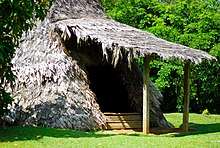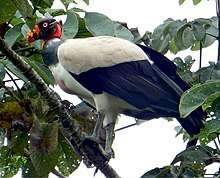Bribri people
The Bribri are an indigenous people of Costa Rica. They live in the Talamanca canton in Limón Province of Costa Rica.[3] They speak the Bribri language and Spanish. There are varying estimates of the population of the tribe. According to a census by the Ministerio de Salud, there are 11,500 Bribri living within service range of the Hone Creek Clinic alone. They are a voting majority in the Puerto Viejo de Talamanca area. Other estimates of tribal population in Costa Rica range much higher, reaching 35,000.
 Map of Costa Rica showing, in blue, the three most important Bribri reserves | |
| Total population | |
|---|---|
| 12,200 (2000)[1] | |
| Regions with significant populations | |
(Buenos Aires, Turrialba, Matina, and Talamanca) | |
| Languages | |
| Bribri, Spanish,[2] Bribri Sign Language | |
| Related ethnic groups | |
| Boruca, Cabécar[2] |
History
The Bribri are indigenous people of the Talamanca region, living in the mountains and Caribbean coastal areas of Costa Rica and Northern Panama. The majority live with running water but many have scarce electricity. They grow cacao, bananas, and plantains to sell and mostly consume beans, rice, corn, and a variety of other produce.
Many Bribris are isolated and speak their own language. This has allowed them to maintain their indigenous culture, although it has also resulted in less access to education and health care. Although the group has the lowest income per capita in the country, they are able to fulfill their basic needs by growing their food, finding medicine, and collecting housing materials in the forest. They also earn money to purchase what they cannot grow themselves through tourism and by selling cacao, bananas, and plantains.
In 1973, the Legislative Assembly of Costa Rica charged the National Committee on Indigenous Affairs (CONAI) with promoting projects on behalf of indigenous communities. In 1976, President Daniel Oduber Quiros signed Executive Decree No. 5904-G, defining the terms of establishing indigenous reserves. Later that year, Executive Decree No. 6036-G established several indigenous reserves, which the Legislative Assembly ratified on November 16, 1977, in Indigenous Law No. 6172.[4]
Culture and spirituality
The Bribri people live in the mountains and islands of southern Costa Rica and northern Panama both on reservations and non-protected areas.
The Bribri social structure is organized in clans. Each clan is composed of an extended family. The clan system is matrilineal; that is, a child's clan is determined by the clan his or her mother belongs to. This gives women a very important place in Bribri society since they are the only ones that can inherit land and prepare the sacred cacao (Theobroma cacao) drink that is essential for their rituals. Men's roles are defined by their clan, and often are exclusive for men. Examples of these roles are the "awa" or shaman, and the "oko", the only person allowed to touch the remains of the dead, sing funeral songs, and prepare the food eaten at funerals.
Cacao, as in most of the indigenous groups in southern Costa Rica and northern Panama, has a special significance in Bribri culture. For them the cacao tree used to be a woman that Sibú (God) turned into a tree. Cacao branches are never used as firewood and only women are allowed to prepare and serve the sacred drink. Cacao is used in special occasions, ceremonies and in certain rites of passage such as when young girls have their first menstruation. Currently there exists several Bribri women's associations that produce organic, hand made chocolate that helps them in their livelihoods.
The Shaman, or "awa" holds a very important place in Bribri society. Awapa (plural for awa) train since they are about 8 years old; the training is said to last between 10 and 15 years. Only certain clans are allowed to become awapa. Since the clan comes from the mother's side of the family, an awa cannot teach his own sons, but rather the sons of his female relatives.
All of the knowledge is transmitted orally from an older awa to the apprentice. Bribri healing practices combine herbal medicine and spiritual healing. In their tradition illnesses can come from evil spirits that come in from the ocean in the west, they can also be caused by the person's immoral behavior, or by witchcraft from envious neighbors. In order to heal, the Awa must learn special songs that allow him to connect to the spirits of the plant, the disease and the person. Once this connection is established the awa converses with all three spirits until, with the aid of the plant spirit, convinces the disease to leave the person.

The Bribri spiritual practice centers about the conical house. Conical houses can be found in many Amazonian groups belonging to the Macro-chibchan language family. The conical house is a symbolic representation of the universe. It is supported by eight pillars symbolizing the animals that helped Sibú construct the Universe. The house has four levels representing the four levels of the world, being the ground level the plane we inhabit. On the second level dwell the spirits of plants and animals, and the owners of the rivers, this is where Sibú's helpers live. On the third level of the universe live the spirits who cause disease and suffering and descend periodically to cause grief on earth. The final and highest level of the conical house is where Sibú, accompanied by his helper the king of vultures lives. In this same level live the most malign spirits as well. The Bribri explanation for this is that Sibú keeps them enclosed there, like a warden keeps the inmates in a prison. There are also three other levels beneath the world we inhabit. One of them is the place where Bribri souls go after death.

The king vulture (Sarcoramphus papa) holds an important place in the Bribri cosmology. He is the only one that can fly high enough to reach the top of the Universe and thus serves as a link between Sibú and the other worlds. It is believed that while regular vultures, who are his helpers, roost in trees like other birds, the vulture king rises up to sleep with Sibú after eating.
Agriculture is the main activity of the Bribri. The Bribri are isolated, and have developed an extensive bartering system. One small group of Bribri, who live in the community called Kekoldi, only has about 200 people. They partake in the unique practice of iguana farming. These iguanas are released into the forest so any other Bribri can hunt them for their food and skin.[5] The farm has been operating for 11 years and has about 2,000 iguanas and 2,000,000 eggs. The iguanas stay on the farm until five years of age at which time they are released into the wild. The Kekoldi have maintained their own culture.
Non-profit organizations in the area
El Puente[6] is a non-profit organization working with the Bribri people, offering educational assistance, food, and micro-loans. Their goal is to help families and individuals become self-sufficient. El Puente also offers educational working volunteer opportunities, including documentation and preservation of an extensive medicinal plant garden, working with the curandero as he uses indigenous healing methods, assisting in an ongoing job development program, development of Guadua Bamboo as a reforestation alternative both inside and outside of the indigenous reserve.
Surf For Life[7] is a non-profit organization designed to connect travelers with community service activities benefitting coastal communities around the world. Their mission is to assemble teams of 'voluntourists' to travel to various project sites where they serve as hands-on workers and goodwill advocates. Volunteers team up to raise money for projects benefiting the Bribri. In March 2010, Surf For Life teams successfully restored the core structure and wooden planks of a suspension bridge up in the mountains. Now the families living on the other side of the river can safely use the bridge again for everyday access to necessities like food and water supplies, school and medical services.
The Tropical Adventures Foundation[8] works inside the reservation. They provide training to help the Bribri create sustainable income for their communities, while striving to help the tribe preserve their language and culture. Tropical Adventures welcomes volunteers and provides opportunities including: teaching English, recycling and environmental education, medicinal plant project, organic farming, wildlife rehabilitation, chocolate factory, public relations and marketing, retirement home assistance, painting, building and general maintenance, elementary school projects, and trail maintenance.
Project Talamanca[9] provides free medical and dental care to the BriBri and Cabécar people of Talamanca, in cooperation with the CCSS (Caja Costarricense de Seguro Social[10]) and local tribal organizations. Under the direction of the founder, Dr. Peter S. Aborn DDS, groups of professional and student volunteers treat patients in week-long visits to the reserve twice a year.[11][12][13] Dr. Aborn's team of volunteers is committed to providing free care to patients in the least accessible regions of Talamanca. They are also doing research into viral diseases that are endemic to the area, and sponsoring a scholarship for a Bribri student to study dentistry professionally.
References
- Bribri language at Ethnologue (16th ed., 2009)
- "Boruca, Bribri, and Cabécar - Orientation." Countries and Their Cultures. (retrieved 30 Nov 2011)
- For a book-length study see Alanson Skinner, Notes on the Bribri of Costa Rica (Museum of the American Indian, Heye Foundation, 1920).
- Palmer, Paula. (1993). Taking care of Sibö's gifts : an environmental treatise from Costa Rica's KéköLdi Indigenous Reserve. Sánchez, Juanita., Mayorga, Gloria. (2nd ed.). San José, Costa Rica: Asociación de Desarrollo Integral de la Reserva Indígena Cocles/KéköLdi. pp. 63–64. ISBN 9977880190. OCLC 30936235.
- Palmer, Paula. (1993). Taking care of Sibö's gifts : an environmental treatise from Costa Rica's KéköLdi Indigenous Reserve. Sánchez, Juanita., Mayorga, Gloria. (2nd ed.). San José, Costa Rica: Asociación de Desarrollo Integral de la Reserva Indígena Cocles/KéköLdi. pp. 74–78. ISBN 9977880190. OCLC 30936235.
- El Puente - The Bridge
- Surf For Life
- Tropical Adventures
- "Project Talamanca". Archived from the original on 2009-08-04. Retrieved 2009-03-04.
- Caja Costarricense de Seguro Social
- U.S. and Tico dentists bring skills and hope to Talamanca Archived August 4, 2009, at the Wayback Machine
- Talamanca volunteers handle another 600 dental patients
- Solidarity penetrates the mountains of Talamanca